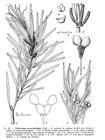Conservation Status

Podocarpus novae-caledoniae
Vieill. ex Brongn. & Gris (1866)
Common names
Taxonomic notes
Syn.: Nageia novae-caledoniae (Viell.) Kuntze 1891 (Farjon 1998); Podocarpus beecherae de Laubenfels 2003. Farjon (2010) provides a fairly detailed rationale for reducing P. beecherae to synonymy with P. novae-caledoniae; the crux of his argument is that no characters reliably serve to distinguish the species except color of the ripe fruit (purple in P. novae-caledoniae, greenish in P. beecherae), and that this is not a sufficient distinction to warrant describing a new species. Although de Laubenfels (2015) places the two taxa in different subsections based on morphological characters, the only molecular study to date that has evaluated essentially all taxa in Podocarpus (Khan et al. 2023) placed P. beecherae sister to P. novae-caledoniae.
Description
Shrubs 1-2 m tall, rarely a small tree to 6 m tall, densely branched with an erect, rounded crown, elongated on tall specimens. Bark fibrous, light brown weathering gray. Twigs numerous, slender, round, glabrous, minutely grooved between leaf bases. Foliage buds small, ovoid or subglobose, subtended by imbricate, appressed, triangular, weakly keeled, 1–2 × 0.5 mm bud scales. Leaves on juvenile plants larger than on adult plants, otherwise similar. Leaves on adult plants 4-8 cm × 3-5 mm, linear, straight or slightly falcate, widening gradually or abruptly from a 3-5 mm petiole, the sides approximately parallel, the apex gradually tapering, acute or obtuse. Adaxial midrib often in a shallow groove or V-shaped depression; abaxial midrib obtusely raised; leaf coriaceous, lustrous light green above, dull green below, stomata numerous and small in two wide bands of intermittent lines on the abaxial surface. Pollen cones axillary, sessile, 1(-3) together, cylindrical, 7-18 × 2-2.5 mm at maturity, yellow turning brown, microsporophylls very small, triangular, with 2 sublateral globose pollen sacs. Seed cones solitary, axillary on 5-15 mm long slender peduncles, receptacle subtended by 2 small recurved bracts, and composed of 2-3 fertile bracts that fuse and become swollen, succulent, yellow-green to orange or dark red, 9-12 × 6-8 mm. Seeds 1(-2) in receptacle, within a pale green epimatium, 6-8 × 5-6 mm, maturing light brown (Farjon 2010).
Distribution and Ecology
New Caledonia: Grande Terre (Province Sud) and Ile de Pins (de Laubenfels 1972). Restricted to ultramafic substrates in the southern part of the island, elevation 0-700 m. Often riparian, growing with shrubs and small trees of the "maquis minier" vegetation type, often forming bushy thickets. Commonly with Dacrydium araucarioides (Farjon 2010).
This map shows herbarium records of Podocarpus species native to New Caledonia. Red is P. decumbens, dark green is P. gnidioides, orange is P. longifolioliatus, yellow is P. lucienii, purple is P. novae-caledoniae, green is P. polyspermus, and blue is P. sylvestris. Click on an icon for further information. Distribution data from GBIF (2020.03.30), edited to remove duplicates.
The IUCN reports that the population status is stable.
Remarkable Specimens
Ethnobotany
No use is recorded. It has not yet found use as an ornamental and is rare in botanical gardens.
Observations
Remarks
Citations
Brongniart, A. T. and J. A. A. Gris. 1866. Annales des Sciences Naturelles; Botanique sér. 5, 6:242. Available: Biodiversity Heritage Library, accessed 2025.02.23.
Khan, R., Hill, R. S., Liu, J., and Biffin, E. 2023. Diversity, distribution, systematics and conservation status of Podocarpaceae. Plants 12(5):1171. https://doi.org/10.3390/plants12051171.
Laubenfels, D.J. de. 2003. A new species of Podocarpus from the maquis of New Caledonia. New Zealand Journal of Botany 41: 715-718.
Laubenfels, D. J. de. 2015. New sections and species of Podocarpus based on the taxonomic status of P. neriifolius (Podocarpaceae) in tropical Asia. Novon 24(2):133–152. https://doi.org/10.3417/2012091.
See also
Association Endemia, a site devoted to New Caledonian species. Has excellent photos, a range map, and other information. In French.
Gray, Netta E. 1958. A Taxonomic Revision of Podocarpus, XI. The South Pacific Species of Section Podocarpus, Subsection B. Journal of the Arnold Arboretum 39:474. Available: Biodiversity Heritage Library, accessed 2023.01.08.



